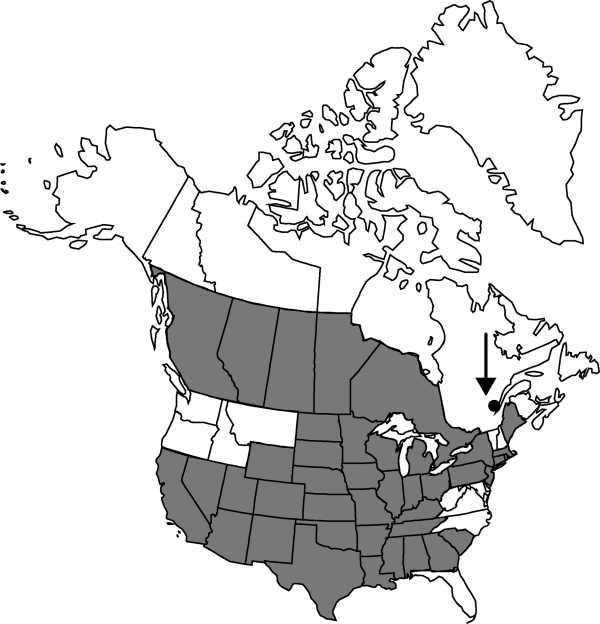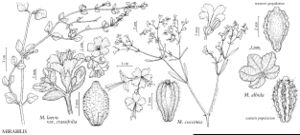Mirabilis albida
Annuaire Conserv. Jard. Bot. Genève 5: 182. 1901.
Stems 1–many, erect to decumbent, few or highly branched, sparsely to densely leafy in basal 1/2 or throughout, 0.8–15 dm, glabrous to puberulent basally in 2 lines or throughout, hairs often awned, or stems villous and often viscid, or sometimes hirsute, hair types often mixed, spreading pubescent. Leaves ascending to spreading at 10–90°; petiole 0–4 cm; blade green to glaucous blue-gray, linear-lanceolate to ovate-lanceolate, ovate, or deltate, 1–11 × 0.6–2.5 cm in lanceolate leaves, 2–9 × 1–6.5 cm in ovate leaves, thin and fleshy to thick and coriaceous, base cuneate to round, truncate, or cordate, apex acute, obtuse, or round, surfaces glabrous or viscid-puberulent, viscid-villous, or hirsute. Inflorescences axillary or terminal, few branched, ± evenly forked and open, or, when axillary, often consisting only of single involucres (and then flowers commonly cleistogamous); peduncle 1–25 mm, puberulent with curled hairs, hispid, villous, or viscid-villous, crosswalls of hairs pale; involucres pale green or sometimes blushed with purple when young, widely bell-shaped, 4–7 mm in flower, 5–15 mm in fruit, sparsely to densely pubescent with small curled hairs or long spreading hairs, often viscid, 50–80% connate, lobes ovate, triangular-ovate, broadly ovate, or occasionally round. Flowers (1–)3 per involucre; perianth white, pink, or deep red-violet, 0.8–1.5 cm. Fruits brown to dark brown with pale tan, brown, or dark brown ribs, obovoid to narrowly obovate and tapering at both ends, 3.5–5.5 mm, pubescent with tufted spreading hairs 0.1–0.5 mm, with or without minute glandular hairs; ribs round or round-angled, (0.3–)0.7–1.5 times width of sulci, 0.5–1 times as wide as high, with tall shelflike tubercles (eastern part of range), smooth or somewhat rugose or moderately tuberculate (western part of range); sulci with prominent, pale, shelflike tubercles (eastern), minutely rugose or with small low warts (western). 2n = 58.
Phenology: Flowering late summer–early fall.
Habitat: Dry meadows, sandy prairies, hillsides, rocky slopes
Elevation: 0-2600 m
Distribution

Alta., B.C., Man., Ont., Que., Sask., Ala., Ariz., Ark., Calif., Colo., Conn., Ga., Ill., Ind., Iowa, Kans., Ky., La., Maine, Mass., Mich., Minn., Miss., Mo., Nebr., Nev., N.J., N.Mex., N.Y., N.Dak., Ohio, Okla., Pa., S.C., S.Dak., Tenn., Tex., Utah, Wis., Wyo., Mexico.
Discussion
In the eastern half of the continent, Mirabilis albida is reasonably uniform, usually erect, with lanceolate or narrowly oblong leaves, and fruits with large, wartlike tubercles on ribs and sulci. These fruits are very similar to those of M. nyctaginea, except they are usually yellowish brown rather than reddish brown. On the western plains, M. albida intergrades with M. linearis. R. Spellenberg (1998), in attempting to maintain a fairly uniform M. albida, provided a table distinguishing among it, M. oblongifolia, and M. melanotricha. Distinguishing leaf forms of M. oblongifolia as circumscribed by C. F. Reed (1969) from western races of M. albida becomes untenable, as proposed by B. L. Turner (1993b). Individual specimens are sometimes very different, but in a series of populations distinctions merge. The minute glandular hairs beneath the tufts of larger hairs and the presence of large, shelflike tubercles are fairly consistent throughout the eastern half of the continent. In the southwestern mountains, where M. oblongifolia in the broad sense occurs, and in the northern Rocky Mountains, where M. lanceolata occurs (as these phases in the complex have been named), both features are either inconsistent or absent, the fruits becoming much less warty and more like those of M. linearis. Some phases, such as M. comata, and Allionia pratensis, seem to form reasonably recognizable geographically and ecologically restricted populations and may be worthy of taxonomic recognition, perhaps at the infraspecific level. The type of M. hirsuta has the general form of broad-leaved plains races of M. albida is lightly hispid on basal parts. The exceedingly hispid, broad-leaved forms commonly identified as M. hirsuta from near the eastern base of the Rocky Mountains are here recognized as M. rotundifolia; the hispid narrow-leaved phases from the southwestern plains are included within M. linearis.
Selected References
None.
